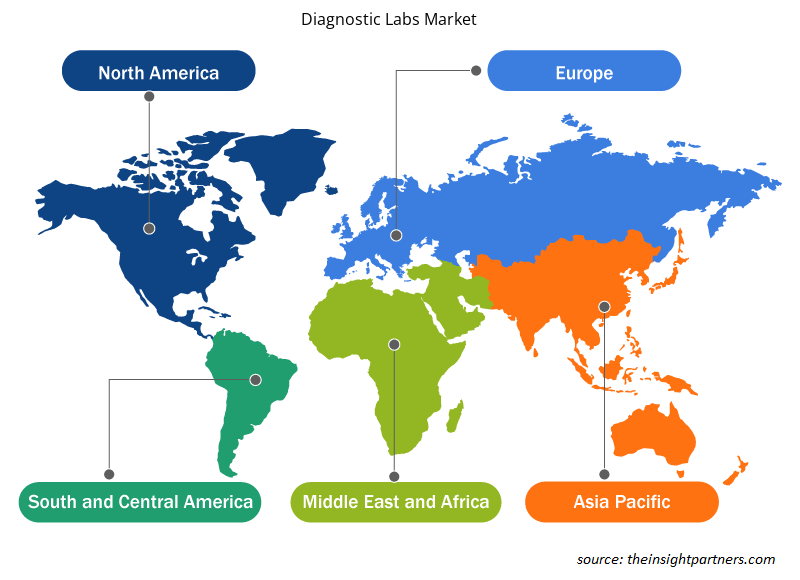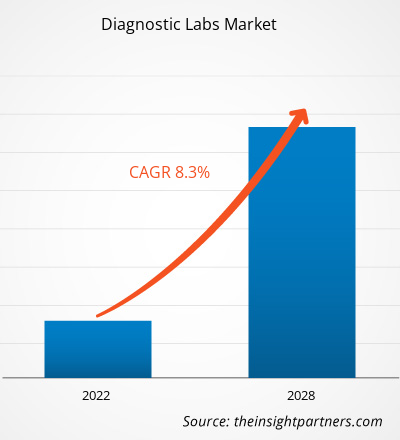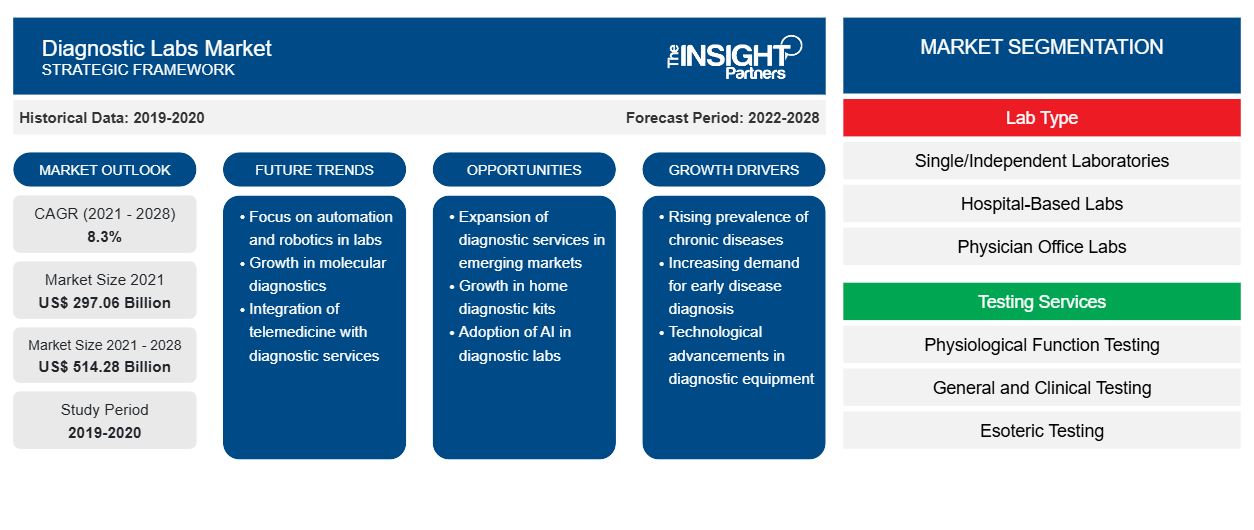[Forschungsbericht] Der Markt für Diagnoselabore soll von 297,06 Milliarden US-Dollar im Jahr 2021 auf 514,28 Milliarden US-Dollar im Jahr 2028 wachsen; von 2022 bis 2028 wird mit einer durchschnittlichen jährlichen Wachstumsrate von 8,3 % gerechnet.
Die zunehmende Verbreitung chronischer Krankheiten, der zunehmende Einsatz von Point-of-Care-Diagnostik und die steigenden Gesundheitsausgaben begünstigen das Wachstum des Marktes für Diagnoselabore. Darüber hinaus dürften sich die wachsenden Entwicklungen in Diagnoselaboren von 2022 bis 2028 als bedeutender Zukunftstrend auf dem Markt für Diagnoselabore herausstellen . Ein Mangel an qualifizierten Fachkräften behindert jedoch das allgemeine Marktwachstum.
Infolgedessen begann das Zeitalter der Gesundheitstechnologie und verwandelte das Gesundheitswesen in ungeahnte Höhen. Seitdem sind verschiedene Start-ups entstanden, die die Branche mit Innovationen wie Telemedizin, Telekonsultation und insbesondere diagnostischen Lösungen revolutioniert haben. Diagnostiklabore bilden das Rückgrat des Gesundheitswesens. Die Einführung von Technologie ist unerlässlich, um die steigende Nachfrage der Verbraucher zu befriedigen und einen Wettbewerbsvorteil auf dem Markt zu haben. Vor diesem Hintergrund nutzen die Akteure der Branche die Macht der Technologie, um Gesundheitslösungen der neuen Generation anzubieten. Die in Diagnostiklaboren verwendete Technologie bewegt sich mithilfe der neuesten Entwicklungen in den Bereichen künstliche Intelligenz (KI) und maschinelles Lernen (ML) rasch in Richtung einer vollständigen Transformation. Von der Entwicklung genauer und effizienter diagnostischer Lösungen bis hin zur Anpassung an technologische Eingriffe arbeiten verschiedene zukunftsorientierte F&E-Teams bereits an der Entwicklung neuerer und einfacherer Methoden zur Blutanalyse und -diagnose. Einige der Entwicklungen auf dem Markt für Diagnostiklabore sind wie folgt:
- Im Januar 2019 brachte Roche die integrierten Lösungen von Cobas pro in allen Ländern auf den Markt, die das CE-Zeichen akzeptieren. Das Produkt hat neue Standards in puncto Wartung, Effizienz und Zuverlässigkeit gesetzt, indem es die Patientenzufriedenheit erhöht und die Kosten der Gesundheitsversorgung senkt.
- Im Februar 2020 brachte Ortho Clinical Diagnostics ein klinisches Chemiesystem auf den Markt, das seine integrierte Vitros XT-Linie vervollständigte und die meisten typischen Labortests abdeckt. Das Unternehmen schätzte seinen maximalen Durchsatz auf 755 Tests pro Stunde mit Einzeltest-Objektträgern und 1.130 Tests pro Stunde mit Doppeltest-Objektträgern. Darüber hinaus erhielt das XT 3400-System des Unternehmens die CE-Kennzeichnung und ist in den USA, Kanada, Europa, Indien, Japan und einigen Ländern im Nahen Osten und Afrika erhältlich.
- Im September 2021 gab Ortho Clinical Diagnostics die Verfügbarkeit von Immediate Spin Crossmatch (ISXM) auf den Analysegeräten Ortho Vision und Ortho Vision Max des Unternehmens bekannt, um bei der Identifizierung von Empfänger-Spender-Inkompatibilitäten bei Bluttransfusionen zu helfen.
Daher würden solche Entwicklungen dem Markt für Diagnostiklabore in Kürze einen Aufschwung verleihen.
Passen Sie diesen Bericht Ihren Anforderungen an
Sie erhalten kostenlos individuelle Anpassungen an jedem Bericht, einschließlich Teilen dieses Berichts oder einer Analyse auf Länderebene, eines Excel-Datenpakets sowie tolle Angebote und Rabatte für Start-ups und Universitäten.
- Holen Sie sich die wichtigsten Markttrends aus diesem Bericht.Dieses KOSTENLOSE Beispiel umfasst eine Datenanalyse von Markttrends bis hin zu Schätzungen und Prognosen.
Es wird geschätzt, dass Nordamerika seine Dominanz auf dem Markt für Diagnoselabore in den Jahren 2022–2028 beibehalten wird. Es wird erwartet, dass die Region im Prognosezeitraum eine erhebliche Nachfrage nach Diagnoselaboren verzeichnen wird, was auf die zunehmende Einführung technologischer Fortschritte und die steigenden Forschungs- und Entwicklungsaktivitäten in dieser Region zurückzuführen ist. Eine verbesserte Gesundheitsinfrastruktur und angemessene Erstattungsrichtlinien unterstützen ebenfalls den nordamerikanischen Markt für Diagnoselabore. Es wird erwartet, dass die USA von 2022 bis 2028 den größten Marktanteil auf dem nordamerikanischen Markt halten werden. Es wird erwartet, dass der Markt in den kommenden Jahren aufgrund der zunehmenden Einführung technologischer Fortschritte und der zunehmenden Betonung der Verbesserung der Behandlungsergebnisse wachsen wird. Die US-Diagnoselabore dienen als Grundlage für die Frühdiagnose, Prävention und personalisierte Versorgung von Millionen von Patienten und beschleunigen die Nachfrage in großem Umfang. Beispielsweise umfassen Frühdiagnose, Prävention und personalisierte Versorgung in Diagnoselaboren in den USA routinemäßige Bluttests von Patienten und bahnbrechende genetische und molekulare Diagnostik. Laut dem Bericht der American Clinical Laboratory Association (ACLA) spielen Diagnoselabore eine entscheidende Rolle bei der Verbesserung der Behandlungsergebnisse und der Lebensqualität der Patienten und bieten dem Gesundheitssystem einen besseren Nutzen im Bereich der Gesundheitsversorgung. Darüber hinaus machen diagnostische Labordienstleistungen nur 2,3 % der US-Gesundheitsausgaben und 2 % der Medicare-Ausgaben aus. Daher sind Diagnoselabore ein wesentlicher Bestandteil des US-Gesundheitssystems und der Patienten, die sie versorgen. Darüber hinaus sind fast 25 % der Qualitätsindikatoren für die US-Patientenversorgung für Erwachsene in Labortests enthalten. Qualitätsindikatoren sind standardisierte, evidenzbasierte Maßstäbe für die Qualität der Gesundheitsversorgung, die von Krankenhäusern, die stationäre Verwaltungsdaten bereitstellen, problemlos zur Verfolgung und Messung der klinischen Leistung und Ergebnisse verwendet werden können. Solche Qualitätsindikatoren spielen eine entscheidende Rolle bei der Gewährleistung einer qualitativ hochwertigen, kosteneffizienten klinischen Versorgung, indem sie Labormedizinern Informationen geben, um objektive wissenschaftliche Daten zu erhalten und eine Interpretation der Ergebnisse von US-Erwachsenen zu liefern. Die oben genannten Faktoren treiben das Wachstum des Marktes für Diagnoselabore voran.
Einblicke in die Einnahmequellen
Basierend auf der Einnahmequelle ist der Markt für Diagnoselabore in Betreiber und Versicherer von Krankenversicherungen, Selbstbeteiligung und öffentliches System unterteilt. Das Segment der Betreiber und Versicherer von Krankenversicherungen wird voraussichtlich zwischen 2022 und 2028 den größten Marktanteil haben. Die Zahl der privaten Versicherer, die anpassbare Versicherungsprodukte anbieten, hat zugenommen. Viele der von der Weltregierung bereitgestellten Bestimmungen ähneln dem Affordable Care Act, der sich auf die Ausweitung der Krankenversicherung konzentriert. Es schafft Anreize für Arbeitgeber, Krankenversicherungen bereitzustellen, und zwingt Personen, die nicht über das Versicherungsprogramm ihrer Regierung oder Arbeitgeber abgedeckt sind, eine private Krankenversicherung abzuschließen. Im Jahr 2018 hatten ~23 % der Weltbevölkerung eine private Kranken-/Krankenversicherung und ~9,6 % eine Zahnversicherung. Darüber hinaus erhalten ~70 % der Begünstigten, die Krankenversicherungsleistungen erhalten, ihre private Krankenversicherung als Arbeitsleistung. Private Krankenversicherungsbetreiber bieten Gesundheitsdienstleistungen über Einrichtungen oder akkreditierte Gesundheitsorganisationen an. Alternativ können sie den Versicherten die Kosten für gekaufte Gesundheitsdienstleistungen erstatten. Die oben genannten Faktoren werden dazu beitragen, das Segment der Krankenversicherungsbetreiber und -versicherer im Prognosezeitraum anzukurbeln.customizable insurance products. Many of the provisions provided by the Global Government are similar to the Affordable Care Act, which focuses on expanding healthcare insurance coverage. It generates incentives for employers to provide health coverage and compels people who are not covered under the insurance program of their governments or employers to purchase private healthcare insurance. In 2018, ~23% of Global had private medical/hospital insurance, and ~9.6% had dental insurance. Moreover, ~70% of beneficiaries, who receive health insurance facilities, receive their private health insurance as an employment benefit. Private health plan operators offer healthcare services through facilities or accredited healthcare organizations. Alternatively, they can reimburse enrollees for purchased health care services. The aforementioned factors will help boost the healthcare plan operators and insurers segment in the forecast period.
Auf dem Markt für Diagnoselabore tätige Unternehmen verfolgen eine Produktinnovationsstrategie, um den sich weltweit entwickelnden Kundenanforderungen gerecht zu werden und so ihren Markennamen auf dem globalen Markt für Diagnoselabore zu behaupten.
Regionale Einblicke in den Markt für Diagnoselabore
Die regionalen Trends und Faktoren, die den Markt für Diagnoselabore im gesamten Prognosezeitraum beeinflussen, wurden von den Analysten von Insight Partners ausführlich erläutert. In diesem Abschnitt werden auch die Marktsegmente und die Geografie von Diagnoselaboren in Nordamerika, Europa, im asiatisch-pazifischen Raum, im Nahen Osten und Afrika sowie in Süd- und Mittelamerika erörtert.

- Erhalten Sie regionale Daten zum Markt für Diagnoselabore
Umfang des Marktberichts zu Diagnoselaboren
| Berichtsattribut | Details |
|---|---|
| Marktgröße im Jahr 2021 | 297,06 Milliarden US-Dollar |
| Marktgröße bis 2028 | 514,28 Milliarden US-Dollar |
| Globale CAGR (2021 - 2028) | 8,3 % |
| Historische Daten | 2019-2020 |
| Prognosezeitraum | 2022–2028 |
| Abgedeckte Segmente | Nach Labortyp
|
| Abgedeckte Regionen und Länder | Nordamerika
|
| Marktführer und wichtige Unternehmensprofile |
|
Dichte der Marktteilnehmer im Bereich Diagnoselabore: Die Auswirkungen auf die Geschäftsdynamik verstehen
Der Markt für Diagnoselabore wächst rasant, angetrieben durch die steigende Nachfrage der Endnutzer aufgrund von Faktoren wie sich entwickelnden Verbraucherpräferenzen, technologischen Fortschritten und einem größeren Bewusstsein für die Vorteile des Produkts. Mit steigender Nachfrage erweitern Unternehmen ihr Angebot, entwickeln Innovationen, um die Bedürfnisse der Verbraucher zu erfüllen, und nutzen neue Trends, was das Marktwachstum weiter ankurbelt.
Die Marktteilnehmerdichte bezieht sich auf die Verteilung der Firmen oder Unternehmen, die in einem bestimmten Markt oder einer bestimmten Branche tätig sind. Sie gibt an, wie viele Wettbewerber (Marktteilnehmer) in einem bestimmten Marktraum im Verhältnis zu seiner Größe oder seinem gesamten Marktwert präsent sind.
Die wichtigsten auf dem Markt für Diagnoselabore tätigen Unternehmen sind:
- Quest Diagnostics GmbH
- Eurofins Scientific
- Laboratorium Corporation of America Holdings
- Exact Sciences Laboratories LLC
- SYNLAB International GmbH
Haftungsausschluss : Die oben aufgeführten Unternehmen sind nicht in einer bestimmten Reihenfolge aufgeführt.

- Überblick über die wichtigsten Akteure auf dem Markt für Diagnoselabore
Markt für Diagnoselabore – Segmentierung
Basierend auf dem Labortyp ist der Markt für Diagnoselabore in einzelne/unabhängige Labore, Krankenhauslabore, Arztpraxislabore und andere unterteilt. Basierend auf den Testdienstleistungen ist der Markt für Diagnoselabore in physiologische Funktionstests, allgemeine und klinische Tests, esoterische Tests , Spezialtests, nicht-invasive pränatale Tests , COVID-19-Tests und andere unterteilt. Nach Einnahmequelle ist der Markt für Diagnoselabore in Krankenversicherungsbetreiber und Versicherer, Selbstbeteiligungen und öffentliches System unterteilt. Basierend auf der Geografie ist der Markt für Diagnoselabore hauptsächlich in Nordamerika, Europa, Asien-Pazifik, Naher Osten und Afrika (MEA) sowie Süd- und Mittelamerika unterteilt. Der Markt in Nordamerika ist weiter in die USA, Kanada und Mexiko unterteilt. Der europäische Markt für Diagnoselabore ist in Frankreich, Deutschland, das Vereinigte Königreich, Spanien, Italien und das übrige Europa unterteilt. Der Markt im Asien-Pazifik-Raum ist in China, Indien, Japan, Australien, Südkorea und das übrige Asien-Pazifik-System unterteilt. Der Markt für Diagnoselabore im Nahen Osten und Afrika (MEA) ist weiter segmentiert in Saudi-Arabien, die Vereinigten Arabischen Emirate, Südafrika und den Rest des MEA. Der Markt für Diagnoselabore in Süd- und Mittelamerika ist segmentiert in Brasilien, Argentinien und den Rest von Süd- und Mittelamerika.
Firmenprofile
- Quest Diagnostics GmbH
- Eurofins Scientific
- Laboratorium Corporation of America Holdings
- Exact Sciences Laboratories LLC
- SYNLAB International GmbH
- Sonic Healthcare GmbH
- DASA Labs
- Kingmed-Diagnostik
- Healius Limited
- BioReferenz
- Historische Analyse (2 Jahre), Basisjahr, Prognose (7 Jahre) mit CAGR
- PEST- und SWOT-Analyse
- Marktgröße Wert/Volumen – Global, Regional, Land
- Branchen- und Wettbewerbslandschaft
- Excel-Datensatz
Aktuelle Berichte
Erfahrungsberichte
Grund zum Kauf
- Fundierte Entscheidungsfindung
- Marktdynamik verstehen
- Wettbewerbsanalyse
- Kundeneinblicke
- Marktprognosen
- Risikominimierung
- Strategische Planung
- Investitionsbegründung
- Identifizierung neuer Märkte
- Verbesserung von Marketingstrategien
- Steigerung der Betriebseffizienz
- Anpassung an regulatorische Trends























 Kostenlose Probe anfordern für - Markt für Diagnoselabore
Kostenlose Probe anfordern für - Markt für Diagnoselabore